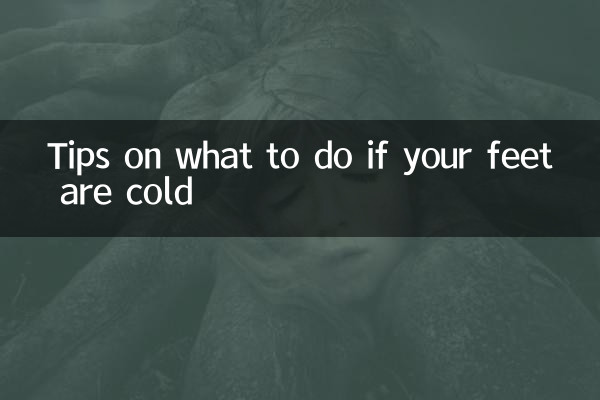Tips on what to do if your feet are cold
With the arrival of winter, the temperature plummets, and frostbite on the feet has become a common problem faced by many people. Cold feet not only cause pain and discomfort, but can also lead to more serious health problems. This article will combine the hot topics and hot content on the Internet in the past 10 days to provide you with some practical tips to help you deal with the problem of cold feet.
1. Reasons for cold feet

Cold feet are usually caused by prolonged exposure to cold environments, resulting in poor blood circulation and local tissue damage. Here are some common reasons:
| reason | illustrate |
|---|---|
| low temperature environment | Activities in a cold environment for a long time, the feet are not kept warm enough |
| moist | Wet feet will accelerate heat loss and increase the risk of frostbite |
| poor blood circulation | Sitting for long periods of time or lack of exercise leads to poor blood circulation in the feet |
| Shoes and socks are inappropriate | The shoes and socks are too tight or the material is not breathable, which affects the warmth of the feet. |
2. Symptoms of cold feet
Symptoms of cold feet vary from person to person, but usually include the following symptoms:
| symptom | describe |
|---|---|
| red or blanched skin | Skin may appear red or pale initially |
| numbness or tingling | Sluggish or tingling sensation in the feet |
| swelling | In severe cases, local swelling may occur |
| blisters or ulcers | Severe frostbite may cause blisters or skin ulcers |
3. Tips on what to do if your feet are cold
The following are the most popular tips for dealing with cold feet in the past 10 days, which can help you quickly relieve symptoms and prevent frostbite:
| coup | Specific operations |
|---|---|
| Soak in warm water | Soak your feet in warm water (37-40℃) for 15-20 minutes to promote blood circulation |
| ginger scrub | Use ginger slices to scrub the frostbitten area. The spicy component of ginger helps activate blood circulation. |
| honey smear | Honey has anti-inflammatory and moisturizing properties and can be applied to frostbitten areas to relieve symptoms. |
| Wear warm shoes and socks | Choose wool or warm shoes and socks to keep your feet dry |
| moderate exercise | Move your toes and ankles regularly to promote blood circulation |
4. Tips to prevent cold feet
Prevention is better than cure, here are the most popular tips on preventing cold feet:
| Tips | illustrate |
|---|---|
| Keep feet dry | Moisture is the cause of frostbite. Change wet socks promptly. |
| Avoid standing still for long periods of time | Move your feet more when sitting or standing for long periods of time |
| diet conditioning | Eat more warming foods such as ginger soup, red dates, etc. |
| Use warm baby | Stick a warm baby inside the shoe to provide continuous heat |
5. When Do You Need Medical Treatment?
If symptoms of cold feet are severe, such as large blisters, black skin, or severe pain, you should seek medical attention promptly. The following are situations that require medical attention:
| Condition | Countermeasures |
|---|---|
| skin ulcers | Seek medical attention immediately to avoid infection |
| persistent pain | Pain that does not relieve for more than 24 hours |
| fever | Fever may be a sign of infection |
Conclusion
Although cold feet are common, they can be effectively alleviated and prevented with the right methods. This article combines hot topics across the Internet to provide you with practical tips and preventive measures. Hope this information helps you have a warm winter!

check the details

check the details